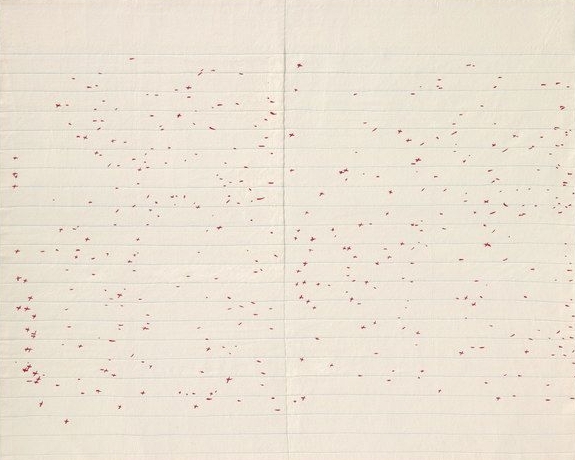Jen Bervin: Marks of Mending


“I like to make ideas wait a while. If they wait around and they keep bothering me, and they keep my curiosity for a long time, then they’re worth working on for a long time.” —Jen Bervin, artist, poet, and researcher, from Make/Time podcast
Visual Translation
In The Dickinson Composite Series, Jen Bervin translates the iconic poetic marks of Emily Dickinson's writing. In doing so, she foregrounds these oft-omitted marks. The lines, plus signs, and variant dashes that tend to pose problems for conventional print formats become the subject here in Bervin's work.
The Composite Marks of Fascicle 16
The series is composed of five 6 x 8 ft quilts. Their titles (The Composite Marks of Fascicle 16, for example) identify their relation to Dickinson's "fascicles," booklets of poems that Dickinson sewed together. What we see when looking at the quilt is much like looking at an open booklet made of transparent sheets (with the words of the poems removed). What is left are the punctuation marks.
Included, too, are some of the words Dickinson would have marked with a plus sign to signify an alternate word choice for a given verse. For a history of how conventional printing standards and editorial choices have impacted the publication of Dickinson's work, read the Noble Oceans article Emily Dickinson: Poetic Gesture.
Jen Bervin elaborates upon what she means in describing these works as a form of "mending:"
"...as a work of putting things that have been taken away back together again. To make an aesthetic system of restitution for the manuscripts so that people could see what had been removed" (from the Make/Time podcast).
Fascicle 16
Dickinson's fascicles were unbound by her first editors after Dickinson's death in 1886. Attempts have been made to reconstitute the booklets (most notably by the editor Thomas Johnson, and later, R.W. Franklin).
Below are poems 1, 2, 3, 6, 9; the manuscripts of the remaining six poems that comprise Fascicle 16 are unlocatable online.
Dickinson would sew the booklets with red and white twisted thread. Note the two holes near the binding of each page. (Images courtesy of Houghton Library, Harvard University, Cambridge, MA, from Emily Dickinson Archive.)
Additional Resources
Bervin's work can best be described as interdisciplinary, meticulous, and rooted in both "the search" and in research. Visit Jen Bervin's website to view additional works. To hear her speak about her work, listen to the Make/Time podcast episode "Artist as Researcher."
To learn more about Bervin's work with Emily Dickinson's manuscripts, read Noble Ocean's article Emily Dickinson: The Gorgeous Nothings.
To read more about the history of printing Emily Dickinson's work (and the constraints the medium has posed on the full scope of her poetry), read Noble Oceans' article Emily Dickinson: Poetic Gesture.
*Frontispiece
Detail from Jen Bervin's The Composite Marks of Fascicle 16, from The Dickinson Composite Series, 2004-2008.


















